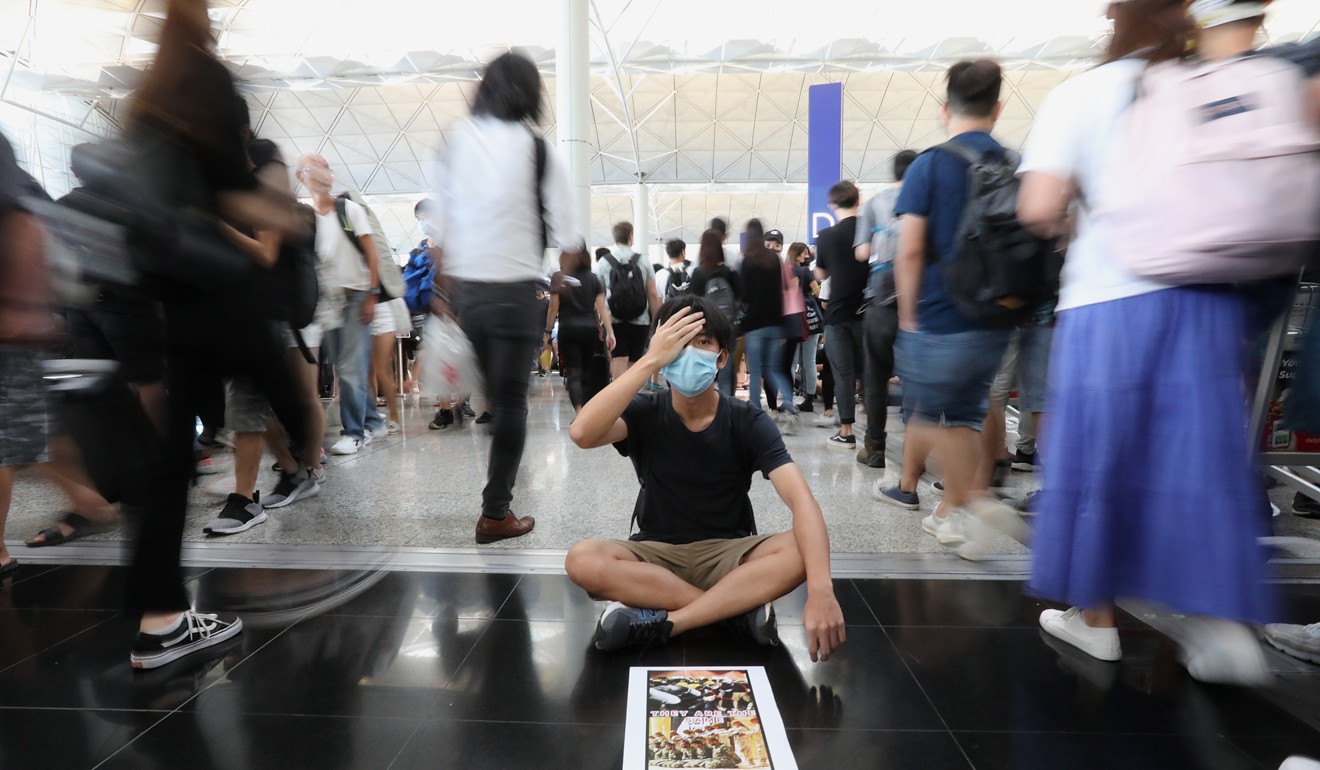
Hong Kong protests: as police and protesters change tactics, is more violence inevitable?
- Woman being shot in eye in Tsim Sha Tsui was one of main incidents to spark latest backlash
- But force dismisses allegation, saying there is insufficient evidence to suggest injury was fault of police
“An eye for an eye” read the placards after a female anti-government protester was allegedly hit by a beanbag round fired by Hong Kong police in Tsim Sha Tsui on Sunday.
It is an injury that could cost the young woman the sight in her right eye.
“Police actions on Sunday made many feel the officers were not following protocol, which put safety and personal property at stake. The protesters have gained the sympathy of the middle class,” said political scientist Dr Edmund Cheng Wai of Baptist University.
“The government has recently been trying to frame the protests as detrimental to the city’s livelihood and economy but now citizens will acknowledge that police power is indeed out of control.”
Tourism workers struggle as protests see earnings slump 74 per cent
But one of the main incidents which sparked the latest backlash was a woman being shot in the eye, allegedly by police, during the unrest in Tsim Sha Tsui. Multiple medical sources said she could lose her eyesight and there were also fractures in her nasal and maxilla, or upper jaw, bones.
As news spread of her injury, thousands of protesters descending on the Lantau Island airport for a sit-in which forced the cancellation of all flights out of Hong Kong from 4pm, as they called for “an eye for an eye”.

Other video footage showed a police officer apparently planting a sharpened bamboo stick into the backpack of a protester in Causeway Bay after he was arrested and handcuffed.
But the force on Monday dismissed the allegations, saying there was insufficient evidence to suggest the eye injury was the fault of police and that it could not identify the cause after watching footage. Some police sources have suggested it may have been a projectile fired from a fellow protester’s catapult.
Flight attendant, audio technician, security guard among latest arrested
“I do not know whether it was a beanbag round, or a metal ball [fired by protesters],” said Terence Mak Chin-ho, assistant commissioner of police (operations).
Senior Superintendent Steve Li Kwai-wah of the organised crime and triad bureau also said it was a huge accusation to suggest officers had planted weapons, which would amount to perverting the course of justice, adding the force would look into the allegation.
The force on Monday for the first time admitted using expired tear gas which had passed its “best before date” since June and promised not to use it again until an ongoing review was over.
Police also revealed that some 240 canisters of tear gas, 30 sponge grenades, 19 rubber bullets and three beanbag rounds had been fired to disperse protesters besieging the legislature on June 12 – a big discrepancy from what they announced that month. Earlier, the force only said more than 150 rounds of tear gas, 20 beanbag rounds and “several” rounds of rubber bullets were used that day.

The use of force by both sides has escalated over recent weeks as the political storm sparked by the now-abandoned extradition bill gradually transformed into an unprecedented movement against the government and police.
Mainland China’s state media and social media on Monday were swamped with reports and commentaries in support of the Hong Kong police and appealing for an end to the violence, many featuring pictures including petrol bomb attacks by protesters on Sunday which left an officer with second-degree burns.
Asian airlines grapple with fallout from Hong Kong airport chaos
Gu Su, professor of philosophy and law at Nanjing University, said most mainland academics had been calling for tougher action by police, which he said might not necessarily be a good sign.
“I think the pan-democratic or opposition camp should participate in negotiations to resolve the issue peacefully as dragging it on will do no one any good,” he said.
“But regrettably, room for such dialogue is nowhere to be seen.”

The professor said the leaders of democratic countries such as Britain and the United States would have resolved social disturbances through dialogue and partial concessions but unfortunately that was not an approach adopted by Chinese authorities.
“[Chinese leaders] think that taking a step back means two steps backward,” he said.
Despite the escalated force – or even hatred – from both sides, Cheng said it was too early to suggest the anti-government protest would end in more violence.
He said protesters had reflected over their strategies on the Reddit-like forum LIHKG – the de facto virtual command centre of the movement – in the past week after some of their more radical actions backfired.
Last week, they hurled petrol bombs into police stations and bricks at disciplined services quarters in Wong Tai Sin which house the families of officers.
“They are thinking of ways to gain public support although that is not the only factor they consider. I believe the movement is moving towards a less violent direction as the radicals are still a small faction,” Cheng said, pointing to the latest sit-in at the airport.
“Anyway, the authorities’ wear-it-out strategy is not working.”
Additional reporting by Echo Xie

